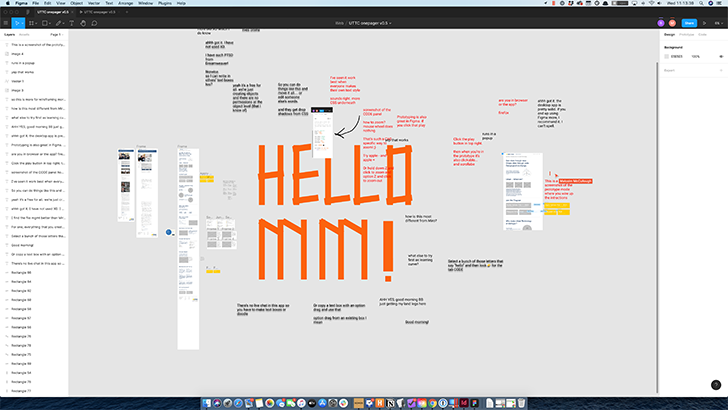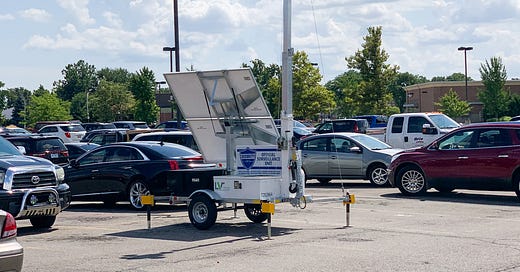Hi, I’m Bryan Boyer, Director of the new Urban Technology degree at University of Michigan’s Taubman College of Architecture and Urban Planning. This newsletter is a behind the scenes view of creating our program that exist at the intersection of cities, technology, and design. Thanks for joining the newsletter!
Cities contain secrets and mysteries. The secrets are things that are known by someone, and usually only a few someones, but not everyone. Mysteries, of course, are happenings without clear explanations. We’re all in the dark to some extent when it comes to the mysteries of cities. So what is this thing, pictured below in the parking lot of a hardware store just outside Detroit?
In a strict sense someone certainly knows what this thing is, so while “OFFICIAL SURVEILLANCE UNIT” may sound un-explanatory and secretive to passers-by, there’s presumably someone who runs hardware store that purchased this sentinel station or pays for it as a service. In theory the people who designed and manufactured it did so with the intent of keeping people safe. But what is it really doing?
That’s where the mystery comes in. So much of what we might consider urban technology sounds good as an idea and gets extremely contested when you dig into it. In that sense, when I got out of my car on the way to buy some paint and saw this thing staring back at me, I was looking into the inky eye of an urban technology mystery.
Does additional video surveillance of the parking lot, beyond the cameras already mounted on buildings, reduce break-ins or whatever crime the creators and installers of this station may have been concerned about? Who exactly did install it? If the video camera record a crime, does it know that a crime has been recored? If so, what computer vision algorithms have been used to interpret the video footage? Who decides if the crime is communicated to the police or not? Who owns the video footage and what restrictions are put on the storage of that video over time?
Can the owners of the video footage re-use the same recordings to measure things beyond crime, such as the average amount of time customers spend in the store? Number of cars in the parking lot? Peak busy times? Is there anything of public value that is produced through this surveillance of the public? And is there even the possibility for the public to decide for themselves if common value is bring created through this surveillance or is it presented ipso facto by the presence of an awkward trailer parked on privately owned property?
In Detroit this is an important topic because of the racial bias that has been shown to be baked into facial recognition algorithms used by the City’s Project Greenlight surveillance camera initiative.
Picking up on last week’s question about what a Michigan ethics of urban technology might entail, one of the things our students need to be able to do is to grab onto mysteries like this Live View security trailer and tug on threads until the net impact of the thing starts to make sense: what were the creators trying to do? Is that a fair and good thing to do? If so, could they accomplish the same goals with lesser harms? If not, how would others be discouraged or prevented from doing the same in the future?
In Urban Technology we are less concerned with the physical design of the thing, in this case rather shoddy, and instead focused on the consequences and outcomes, and how those outcomes are enabled, unleashed, set into motion, or accelerated by the thing.
🤹♀️ Multiplayer Mode Documents
Urban Technology is in launch mode for the next 44 weeks so we are not gearing up to welcome students imminently. Our colleagues teaching Urban Planning and Architecture, however, are in the last minute ramp up to the opening of the semester just 10 days from now.
As they work on adapting super compelling in-person educational experiences to unique and adventurous online versions, Malcom and I spent Wednesday morning to test out multiplayer mode in Figma as he evaluates multiple platforms for use in his studio this semester.
Figma is a remarkable piece of software that’s popular with interaction designers and others building the web because the way that you draw in Figma is a direct translation to the way that you code a user interface. If you’re familiar with Adobe Illustrator, it would be as if Illustrator were designed for use by the graphic designer and the pressmaster who would be firing up the offset printer.
The really cool thing is that it’s a multiplayer application, so when you invite someone else to the app and they open the file at the same time as you, there are suddenly multiple cursors. Two (or more) people can draw, edit, and build together and it works smoothly. Here’s a screenshot from a board mocking up the next version of the Urban Technology website, scattered with liberal comments from Malcom and a big “hello” from me. All the scattered text are chat comments back and forth, interspersed between edits made to the website mockups on the left.

Below is a discussion in Figma with Weiwei Hsu, an interaction designer and curious mind whose expertise and perspective on our nascent program I was quick to seek out. I met Weiwei when she was a student and attended a workshop on future cities that I hosted in Fukuoka. Now she’s working on stuff like an exceptionally cool video app, among other things in Tiny Factories.
Though Figma was created for the design of user interfaces (apps and websites, really) it’s nice to use/abuse it for chat and discussion because it has a zoom feature that works like a graphics app instead of a text editor. From Big picture views like the screenshot of my discussion with Malcolm above you can zoom into details like this comment from Weiwei below.

Using a multiplayer app like Figma (or Google Docs) feels alive. It has changed my thinking about what’s “normal” for interactions with a piece of software such that now when I use a non-multiplayer app it feels lonely. Using a multiplayer apps is like being in a city; single player apps feel like being alone in the forest. The latter has its place, but it’s an odd default. More multiplayer software please!
Links
👻 Zillow Research has posted their 2020 Urban-Suburban Market Report and here’s what they say about the impact of COVID-19: a whole heck of a lot of people are about to move out of San Francisco. Lots more interesting datapoints in the report.
🛩Someone accidentally marked a Melbourne building as 212 stories tall in Open Street Map which is causing a heck of an easter egg in Microsoft’s Flight Simulator app.
This week: Discussions with Simon Sylvester-Chaudhuri of Smart Cities NY conference about urban technology in New York and Detroit, and an incredibly generous hour of wisdom from Allan Chochinov. Sketching a set of ‘signals’ we will track as a program to know if we’re growing in the right way. Laying some groundwork for a podcast (?) or series of discussions to have this autumn with leaders in the field, including suggestions from Rob, Malcolm, and maybe you—who should we be learning from? 🏃♂️



